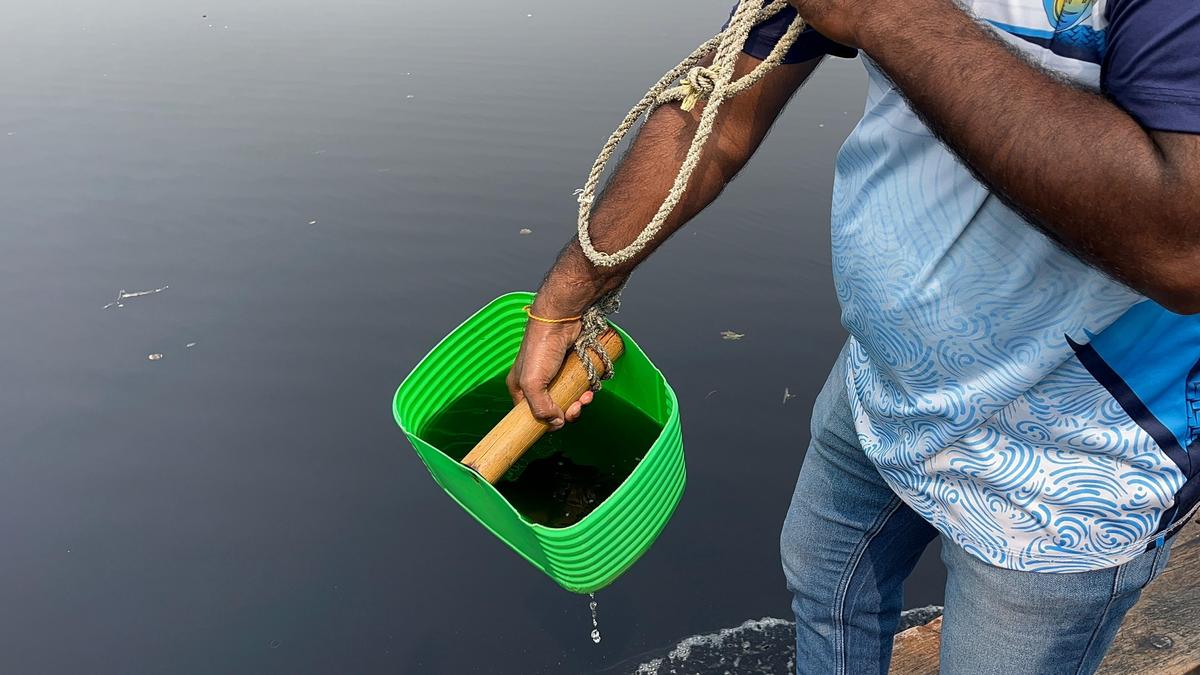
Industrial pollution kills marine life in Navi Mumbai, traditional fishermen to move High Court
The Hindu
Water bodies in Navi Mumbai heavily polluted with toxic chemicals, threatening marine life and traditional fishing communities.
Sample test reports of water bodies in Navi Mumbai reveal heavy levels of toxic chemicals in the creeks, lakes and rivers. The water bodies that are home to marine life, migratory birds and the only livelihood option for the traditional fishermen for generations, have turned black and left with only dead marine life. The traditional fishermen to approach the Bombay High Court in February with a Public Interest Litigation (PIL) petition raising concerns over the drying water bodies due to heavy industrial pollution.
The lab test report of water samples collected from lakes, creeks and rivers revealed that the appearance of the water is grey in colour; total suspended solids found 83 (milligrams per liter) mg/l whereas the normal requirement is maximum 50. Total dissolved solids observed were 17123 mg/l whereas the normal requirement is maximum 2,100. The chemical oxygen demand found was 3,470 mg/l whereas, requirement was maximum 250. The biochemical oxygen demand is found to be 1154 mg/l whereas the normal requirement cannot exceed maximum 20. Fecal coliform is recorded at 2680 mg/l whereas the maximum requirement is 1000 mg/l.
Members of Maharashtra Small Scale Traditional Fish Workers Union wrote to the State government, fisheries department, environment department, Konkan and Raigad district administration numerous times raising the concerns of dead marine life but in vain. The complaint letter highlights fishing zones around Kharghar, Mansarowar and Diwale creek which are rich-intertidal fishing zones for hundreds of traditional fishing families for centuries.
Nandakumar Waman Pawar, environmentalist and president of the organisation said, “In the last 10 years, under the guise of development, we have permanently lost our traditional trade of fishing. Due to anthropogenic activities on the coastline, chemical units and MIDC which are operating in Navi Mumbai area have impacted all traditional fishing zones. Untreated affluents are being released directly into the middle of Diwale creek and this pipeline has been proposed to be stretched up to Belapur creek. We strongly oppose this project as we fear this will destroy Thane and Nhava Sheva creeks that merges with Arabian sea.”
Mr. Pawar has made multiple visits to assess the condition of the water bodies and has found, “The water has turned completely jet black and smells of chemicals. There is not a single living organism left; one can easily spot bubbles emerging often. We are filing a public interest litigation (PIL) at the Bombay High Court in February.”
An official from Panvel Municipal Corporation (PMC) said that that they have had numerous complaints against the industrial units that are set up around the water bodies that are ecologically sensitive and are natural habitats for migratory birds.
There are about 3,254 industrial units of various category engaged in the manufacturing of chemicals, dyes, dye-intermediates, bulk drugs, pharmaceuticals, textile auxiliaries, pesticides, petrochemicals, textile processors, engineering units etc. PMC official said that they had run several water quality tests from several water bodies including Diwale creek and they had found the water to be acidic in nature, enough to destroy living organisms in the waterbodies.

Given that the proposed 250-metre high skydeck and the second airport for Bengaluru cannot be in close proximity of each other, the city’s civic body has now put the skydeck project on the backburner till the location of the proposed second airport is finalised. The decision comes as the State government focuses on finalising land for Bengaluru’s proposed second airport.

Music is not immune to the vagaries of time. Classic rock musician Nandakumar, known popularly as Nandu Leo, has been a witness to the rise, fall and re-emergence of the capital city’s independent music scene, as well as the constant reshaping of tastes of the listeners. Yet, he has stuck to the genre of music he had fallen in love with in his younger days.

 Run 3 Space | Play Space Running Game
Run 3 Space | Play Space Running Game
 Traffic Jam 3D | Online Racing Game
Traffic Jam 3D | Online Racing Game
 Duck Hunt | Play Old Classic Game
Duck Hunt | Play Old Classic Game















